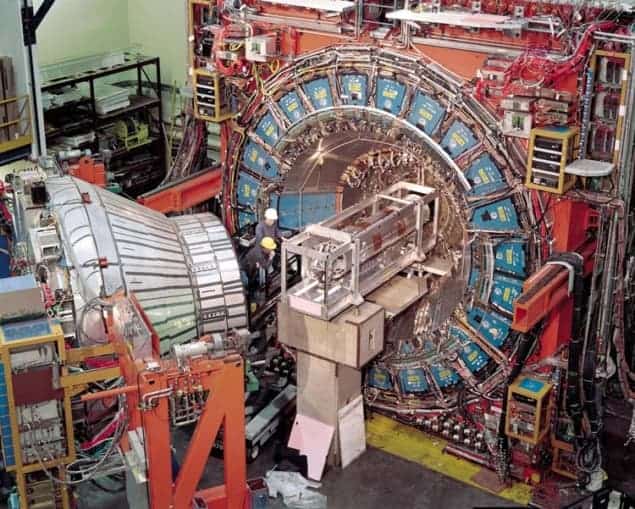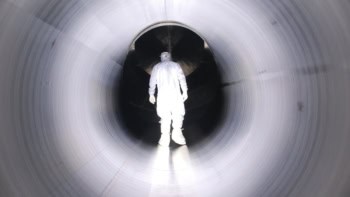
Fermilab’s ageing Tevatron may be due to cease operations at the end of September but for the time being it continues to produce new physics results. Researchers have found that pairs of top quarks and anti-top quarks are produced at the Tevatron with a greater spatial asymmetry than is expected from theory. The result suggests the existence of particles outside of the Standard Model, but this will need to be backed up with more data before physicists overhaul their current theories.
The Tevatron, located at the Fermilab near Chicago, collides protons with antiprotons. Among the many different kinds of particle produced in these collisions are pairs of top quarks and anti-top quarks, generated via the strong force. Detailed calculations reveal that charge should introduce a slight asymmetry when these particles are produced. The reason for this is that the positive charge of a quark contained within an incoming proton tends to repel a top quark very slightly while attracting an anti-top quark, and vice-versa for an incoming antiproton, thereby introducing a small asymmetry into the distribution of outgoing top quarks and anti-top quarks.
Analyses published in 2008 by the CDF and D0 collaborations at Fermilab did indeed provide evidence for this asymmetry. In fact, by carefully measuring the momenta of the particles into which the top and anti-top quark pairs decay, the researchers found that this asymmetry was larger than predicted by the Standard Model. But the discrepancy between theory and experiment was not that significant – the measured value of the asymmetry lying within two standard deviations, σ, of the predicted value.
Now, however, having accumulated a lot more data in the last two years, CDF has found the discrepancy to be more substantial. In particular, the collaboration studied how the asymmetry varies according to the total energy of the top/anti-top pair. At energies of less than 450 GeV (gigaelectronvolts), they found the asymmetry to actually be slightly negative, at –12±15%, but still therefore in line with the Standard Model prediction of 4%. Above 450 GeV, in contrast, they measured an asymmetry of 48±11%, compared with 8% predicted by theory. This anomaly, say the researchers, has a statistical significance of 3.4σ, or less than a 1 in 100,000 chance that it is simply a statistical fluctuation.
Wouldn’t bet their house on it
Despite the apparently very slim chance of the result being a fluke, CDF co-spokesperson Robert Roser says that no-one in the collaboration is “prepared to bet their house on it”. He points out that “sometimes three sigma results turn into five or six sigma whereas others turn into zero sigma”, adding that theorists are publishing new papers every day regarding the possible new particles that might be able to explain this result, but refusing to be drawn into theoretical speculation himself.
Indeed, Tommaso Dorigo, a member of the CMS collaboration at CERN in Geneva, which is also concerned with the analysis of symmetry in particle decays, cautions that the anomaly might not be so large if the uncertainty in the predicted asymmetry has in fact been underestimated. One potential cause of such an underestimation could be the modelling of how quarks and gluons are distributed within the colliding protons and antiprotons. So-called parton distribution functions, he points out, are measured in other experiments and then extrapolated to the energies at which the Tevatron operates and it is possible, he says, that this extrapolation produces a larger uncertainty than estimated. “The predicted asymmetry is just like a soup,” he adds, likening the soup’s recipe to the Standard Model. “There are many ingredients in the soup, and if the soup tastes bad, this may mean that one ingredient was not fresh; it does not necessarily mean that the recipe is wrong.”
Establishing whether or not the latest result is watertight will require collecting more data at the Tevatron, says Roser. As he points out, the Tevatron is ideally suited to studying this asymmetry because the proton/anti-proton collisions automatically lead to pairs of top quarks and anti-top quarks. Producing anti-top quarks at the LHC, in contrast, requires collecting huge amounts of data because the accelerator’s collision energy must be just right to produce an anti-top quark out of the vacuum. Roser adds that he is “disappointed but not surprised” that the Tevatron has not been granted a hoped-for extension beyond September, but expects the US collider to “still dominate the physics landscape for the next year to 18 months”.
The results are presented in a paper submitted to the arXiv preprint server.



